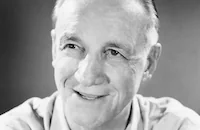He Comes Up Smiling
Brief Synopsis
Cast & Crew
Allan Dwan
Douglas Fairbanks
Herbert Standing
Marjorie Daw
Frank Campeau
Bull Montana
Film Details
Technical Specs

Synopsis
Jerry Martin is a bank clerk whose chief responsibility is to care for Agamemnon, the vice-president's canary. One day the bird escapes, and Jerry frantically pursues it until he meets up with a group of hoboes who suggest that both he and the bird enjoy their freedom. Fascinated by the idea, Jerry lives the carefree life of a wanderer with Baron Bean, a tramp, until his clothes are stolen while he is swimming and he is forced to don the apparel of Batchelor, a stockbroker. With Batchelor's consent, Jerry, in the guise of the financier, lives for several weeks at the home of wealthy businessman John Bartlett and his pretty daughter Billy. When he discovers that Batchelor is trying to ruin Bartlett, Jerry comes to the old man's rescue and is offered a partnership in the business. Jerry's former employer leaves him a substantial inheritance for treating the canary so kindly, and the bank clerk-turned-hobo-turned-millionaire wins Billy's heart.

Director

Allan Dwan
Cast

Douglas Fairbanks
Herbert Standing
Marjorie Daw
Frank Campeau
Bull Montana
Albert Mcquarrie
Kathleen Kirkham
Jay Dwiggins
Billy Elmer

Film Details
Technical Specs

Quotes
Trivia
Notes
Wid's credits Joe August with photography. The New York pre-release showing was September 8, 1918. Some sources give the release date as September 9, 1918 and September 29, 1918. Fairbanks starred in the Broadway farce. According to publicity for the film, Fairbanks' palatial home and grounds in Beverly Hills, CA, and director Allan Dwan's home in the Sierra Madre Mountains in California are shown in the film. Some scenes were shot in Bear Valley, CA.












